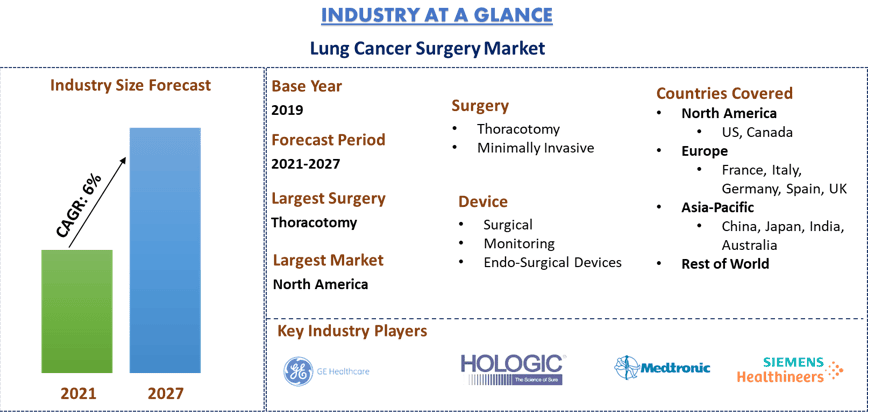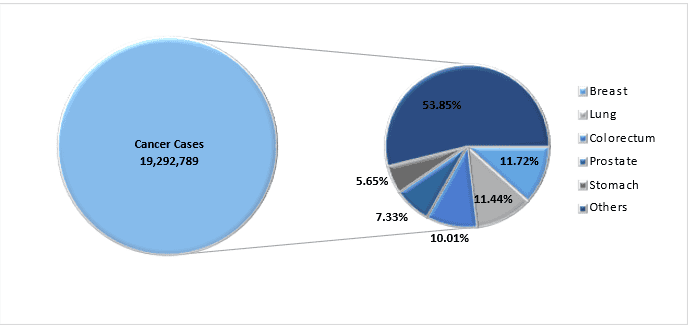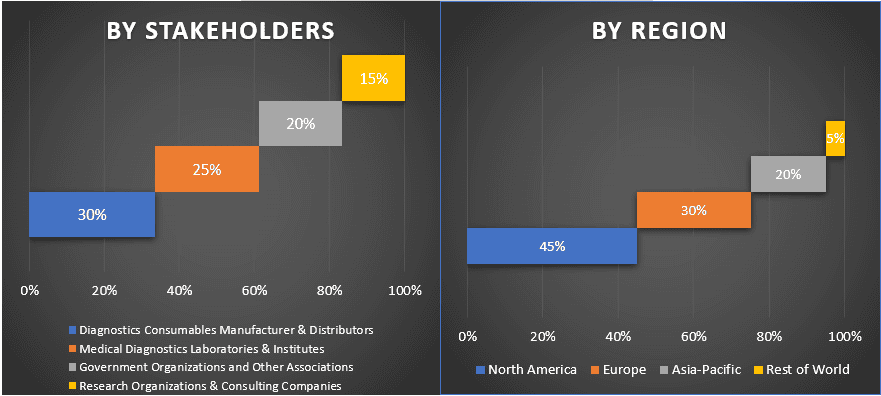- Home
- About Us
- Industry
- Services
- Reading
- Contact Us
Lung Cancer Surgery Market: Current Analysis and Forecast (2021-2027)
Emphasis on Surgery Type (Thoracotomy, Minimally Invasive Surgery), Device Type (Surgical, Monitoring, and Endo-Surgical Devices); and Region & Country.
Conventional cancer treatments are still the most practiced and the most canonical therapies of today`s medical anti-cancer strategies. They comprise surgery, chemotherapy, and radiation therapy, while Lung Cancer Surgery is emerging as the new approach that is further being increasingly accepted and has only recently been innovated and approved. In early 2018, approximately 32 monoclonal antibodies were approved by the FDA or EMA for Lung Cancer Surgery for cancer indication and medical purposes. The surging cancer incidence and rising geriatric population is anticipated to boost the market growth. In 2020, an estimated 19.3 million new cancer cases (18.1 million excluding nonmelanoma skin cancer) will be diagnosed worldwide, with almost 10.0 million cancer deaths (9.9 million excluding nonmelanoma skin cancer).
Lung cancer is the most frequent cancer in the world, and it is growing at a faster rate than breast, colon, and prostate cancers combined. The highest rate of cancer diagnosis is 11.6%, followed by 11.6% for female breast cancer and 10.2% for colorectal cancer. Furthermore, lung cancer is the main cause of cancer morbidity and mortality in men, while it ranks third in incidence and second in mortality in women, following breast and colorectal cancer. Incidence and fatality rates are about two times greater in men than in women, while the male-to-female ratio varies greatly among locations, ranging from 1.2 in Northern America to 5.6 in Northern Africa.
The increase in incidences of cancer globally owing to the increase in the geriatric population has been one of the prime factors that augment market growth. In 2020, according to WHO, cancer was considered among the leading cause of death in the world. Nearly 10 million people die due to cancer each year, making it the second leading cause of death across the world. Nuclear medicine scans can help in finding tumors and analyzing how much cancer has spread in the body (called cancer’s stage). They can also be used to determine whether treatment is effective.
Cancer Cases Worldwide, 2020
GE Healthcare, Johnson and Johnson, Olympus Corporation, Siemens Healthineers AG, Ethicon Inc., Medtronic Plc., and KARL STORZ GmbH are some of the prominent players operating in the Lung Cancer Surgery Market. Several M&As along with partnerships have been undertaken by these players to facilitate customers with hi-tech and innovative products.
Insights Presented in the Report
“Amongst Surgery Type, Thoracotomy segment holds the major share”
Based on the surgery type, the market is fragmented into Thoracotomy and Minimally Invasive Surgery. The thoracotomy segment dominated the market with a share of XX% in 2020 and is expected to maintain its dominance during the forecast period owing to the diverse set of clinically relevant mechanisms of action.
“Amongst Device Type, Endo-Surgical Devices is anticipated to grow at the highest CAGR during the analyzed period”
Based on device type, the market is fragmented into Surgical, Monitoring, and Endo-Surgical Devices. In 2020, surgical devices accounted for a market revenue share of XX% and is expected to reach US$ XX billion during the analyzed period.
“North America signifies one of the largest markets of Lung Cancer Surgery Market”
For a better understanding of the market dynamics of the Lung Cancer Surgery Market, a detailed analysis was conducted for different regions across the globe including North America (United States, Canada, and the Rest of North America), Europe (Germany, France, Italy, Spain, United Kingdom and Rest of Europe), Asia-Pacific (China, Japan, India, Australia, and Rest of APAC), Rest of World has been conducted. North America dominated the market and generated revenue of USD XX billion in 2020. According to the American Cancer Society, there will be around 235,760 new instances of lung cancer in the United States in 2021, (119,100 men and 116,660 women), and approximately 131,880 lung cancer fatalities (69,410 in men and 62,470 in women).
Reasons to buy this report:
- The study includes market sizing and forecasting analysis validated by authenticated key industry experts
- The report presents a quick review of overall industry performance at one glance
- The report covers an in-depth analysis of prominent industry peers with a primary focus on key business financials, product portfolio, expansion strategies, and recent developments
- Detailed examination of drivers, restraints, key trends, and opportunities prevailing in the industry
- The study comprehensively covers the market across different segments
- Deep dive regional level analysis of the industry
Customization Options:
Lung Cancer Surgery Market can further be customized as per the requirement or any other market segment. Besides this, UMI understands that you may have your own business needs, hence feel free to connect with us to get a report that completely suits your requirements.
Table of Content
Analyzing the historical market, estimation of the current market, and forecasting the future market of the global veterinary diagnostics market were the three major steps undertaken to create and analyze the adoption of veterinary diagnostics in different segments across major regions globally. Exhaustive secondary research was conducted to collect the historical market numbers and estimate the current market size. Secondly, to validate these insights, numerous findings and assumptions were taken into consideration. Moreover, exhaustive primary interviews were also conducted, with industry experts across the value chain of the veterinary diagnostics sector. Post assumption and validation of market numbers through primary interviews, we employed a top-down/bottom-up approach to forecast the complete market size. Thereafter, market breakdown and data triangulation methods were adopted to estimate and analyze the market size of segments and sub-segments the industry pertains to. Detailed methodology is explained below:
Analysis of Historical Market Size
Step 1: In-Depth Study of Secondary Sources:
Detailed secondary study was conducted to obtain the historical market size of the veterinary diagnostics through company internal sources such as annual report & financial statements, performance presentations, press releases, etc., and external sources including journals, news & articles, government publications, competitor publications, sector reports, third-party database, and other credible publications.
Step 2: Market Segmentation:
After obtaining the historical market size of the veterinary diagnostics market, we conducted a detailed secondary analysis to gather historical market insights and share for different segments for major regions. Major segments included in the report are product, technology, animal type, and end-user. Further country-level analyses were conducted to evaluate the overall adoption of veterinary diagnostics in every region.
Step 3: Factor Analysis:
After acquiring the historical market size of different segments and sub-segments, we conducted a detailed factor analysis to estimate the current market size of veterinary diagnostics. Further, we conducted factor analysis using dependent and independent variables such as increasing pet population and growing expenditure on animal health. A thorough analysis was conducted for demand and supply-side scenarios considering top partnerships, merger and acquisition, business expansion, and product launches in the veterinary diagnostics industry across the globe.
Current Market Size Estimate & Forecast
Current Market Sizing: Based on actionable insights from the above 3 steps, we arrived at the current market size, key players in the veterinary diagnostics market, and market shares of the segments. All the required percentage shares split, and market breakdowns were determined using the above-mentioned secondary approach and were verified through primary interviews.
Estimation & Forecasting: For market estimation and forecast, weights were assigned to different factors including drivers & trends, restraints, and opportunities available for the stakeholders. After analyzing these factors, relevant forecasting techniques i.e., the top-down/bottom-up approach was applied to arrive at the market forecast about 2027 for different segments and subsegments across the major markets globally. The research methodology adopted to estimate the market size encompasses:
- The industry’s market size, in terms of value (USD) and the adoption rate of veterinary diagnostics across the major markets domestically
- All percentage shares, splits, and breakdowns of market segments and sub-segments
- Key players in the veterinary diagnostics market in terms of services offered. Also, the growth strategies adopted by these players to compete in the fast-growing market
Market Size and Share Validation
Primary Research: In-depth interviews were conducted with the Key Opinion Leaders (KOLs) including Top Level Executives (CXO/VPs, Sales Head, Marketing Head, Operational Head, and Regional Head, Country Head, etc.) across major regions. Primary research findings were then summarized, and statistical analysis was performed to prove the stated hypothesis. Inputs from primary research were consolidated with secondary findings, hence turning information into actionable insights.
Split of Primary Participants in Different Regions
Market Engineering
Data triangulation technique was employed to complete the overall market estimation and to arrive at precise statistical numbers of each segment and sub-segment of the veterinary diagnostics market. Data was split into several segments & sub-segments post studying various parameters and trends in the areas of products, technology, animal type, and end-user of the veterinary diagnostics market.
Main Objective of the Veterinary Diagnostics Market Study
The current & future market trends of veterinary diagnostics were pinpointed in the study. Investors can gain strategic insights to base their discretion for investments from the qualitative and quantitative analysis performed in the study. Current and future market trends were determined the overall attractiveness of the market at a regional level, providing a platform for the industrial participant to exploit the untapped market to benefit as a first-mover advantage. Other quantitative goals of the studies include:
- Analyze the current and forecast market size of veterinary diagnostics in terms of value (USD). Also, analyze the current and forecast market size of different segments and sub-segments
- Segments in the study include areas of products, technology, animal type, and end-users
- Analyze the value chain involved with the presence of various intermediaries, along with analyzing customer and competitor behaviors of the industry
- Analyze the current and forecast market size of the veterinary diagnostics market for the major region
- Major regions studied in the report include North America (the United States and Canada), Europe (Germany, France, Italy, Spain, and United Kingdom), Asia-Pacific (China, Japan, India, and Australia), and the Rest of World
- Company profiles of the veterinary diagnostics market and the growth strategies adopted by the market players to sustain in the fast-growing market
- Deep dive regional level analysis of the industry
Related Reports
Customers who bought this item also bought













